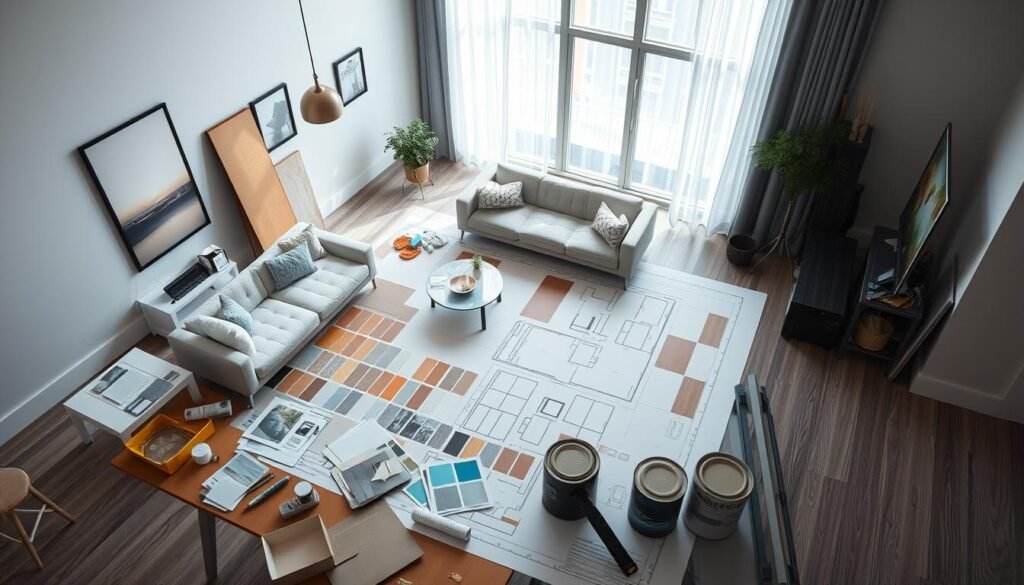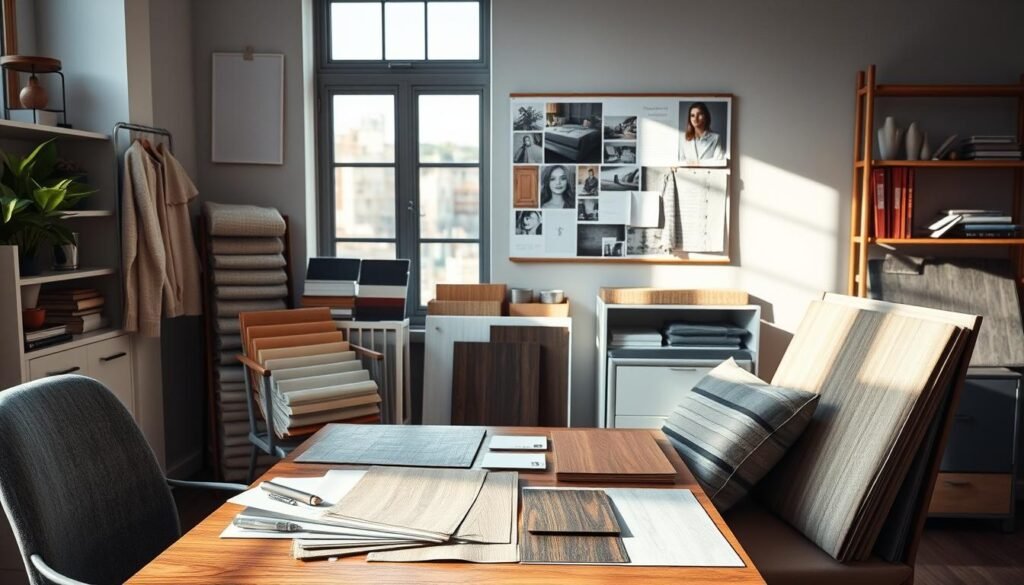Starting a remodel can be thrilling but also overwhelming. Getting your interior ready is key to a successful makeover. It covers everything from planning your space to picking the right colours. Spending time on this step can lower stress and improve your project’s outcome.
A well-prepared interior makes your home more useful and looks better. It opens up new ideas for your renovation that show off your personal style.
Key Takeaways
- Thorough interior preparation can minimise mess and streamline the renovation process.
- Allowing for temporary housing arrangements can ease privacy concerns during extensive projects.
- Cover items with plastic to protect against dust during renovations.
- Daily cleaning, even in short bursts, can help manage dust accumulation.
- Proper budgeting and planning can prevent unexpected costs and issues.
- Involvement in the remodeling process can lead to better outcomes and fewer mistakes.
- It’s crucial to understand and obtain necessary permits before beginning your renovation.
Understanding the Importance of Interior Preparation
In any renovation project, interior preparation is key. It greatly affects the success of your remodel. By fixing issues early, you can make your space look better and work better.
Benefits of Proper Preparation
Good preparation makes your renovation smoother. It has many benefits:
- It saves money by avoiding unexpected repairs.
- It makes finishes last longer, so you don’t need to fix them often.
- It ensures your space looks great with high-quality finishes.
- It makes your space more functional, improving how you live.
Putting in the effort upfront can save you a lot of trouble and money later.
Common Challenges During Renovation
Be ready for common renovation problems, like:
- Unexpected structural issues that can slow things down.
- Delays because of poor planning or indecision.
- Going over budget because of last-minute changes.
- Communication problems between contractors and team members.
Knowing these challenges ahead of time can help you avoid them.
How Preparation Impacts Outcome
Good preparation is essential for a successful project. It affects how your space looks and works. Proper surface treatment is crucial for a lasting finish.
Ignoring this can lead to problems like peeling paint. Fixing small issues early can make a big difference. This effort ensures your project’s success and longevity.
Assessing Your Space Before Renovation
Before starting your renovation, it’s key to do a full space assessment. This helps you see what’s good and what needs work in your current home. Knowing this lets you make better choices for your renovation.
Evaluating Existing Structures
Checking your home’s structures is a must. Look at the layout, how stable it is, and the materials used. You should find:
- Structural integrity: Look for cracks, leaks, and wear that might change your plans.
- Layout efficiency: Spot any odd spaces or areas not used well that could be fixed.
- Accessibility: Think about how easy it is to get around, which is important for changes.
Knowing these things helps you plan better, fitting your new ideas into your home’s current shape.
Identifying Areas for Improvement
As you find what needs fixing, making a list of improvements is crucial. Focus on:
- Functionality: See if the space works for you as it is.
- Aesthetic value: Think about how you can make your home look and feel better.
- Modern amenities: Consider adding new tech and materials for better energy use or lifestyle.
Spending time on this list makes sure your renovation focuses on the biggest improvements. It helps match your dream home with what’s possible.
| Space Assessment Focus | Key Considerations |
|---|---|
| Structural Integrity | Stability, repair needs, potential hazards |
| Layout Efficiency | Flow, functionality, and usage of space |
| Modern Amenities | Technology upgrades, sustainability, energy efficiency |
Creating a Detailed Interior Remodel Plan
Starting an interior remodel needs careful planning. A detailed plan helps set clear goals for the project. Knowing what you want helps guide every decision.
Setting Clear Goals
Before you start, define your goals. Think about what you want to change, like looks, function, or saving energy. Setting priorities makes decisions easier and keeps your vision clear.
Budgeting for Your Remodel
Planning your budget is key to a successful remodel. Renovations can cost between $15 to $60 per square foot. For a 1,250 to 1,600 square foot house, expect to spend around $52,040.
But costs can go up to $189,000. Always save extra, 10% to 20% of your home’s value, for unexpected costs.
Timeline Development
Creating a timeline is important to keep the project moving. Even with the best plans, delays can happen. Permits can take weeks or months.
Plan for delays by preparing for backorders or changes in labor. Working with experts like surveyors can save up to 30% of time.

Selecting the Right Professionals for Your Project
Choosing the right professionals for your renovation is key to success. Working with many specialists helps you get different ideas and skills. Start by researching and checking their qualifications.
Researching Renovation Specialists
First, find a list of local renovation experts. Look at online reviews on Google Reviews or HiPages for top picks. Check:
- Customer testimonials and feedback
- Portfolio showcasing their previous work
- Experience with projects similar to yours
Evaluating Experience and Credentials
It’s crucial to evaluate the experience of your chosen professionals. Look at their past work, focusing on quality and meeting deadlines. Make sure they have the right qualifications and licenses. Ask yourself:
- What professional affiliations do they have?
- Can they provide references from former clients?
- Do they understand local building codes and regulations?
Choosing experienced renovation specialists reduces risks and improves your project’s quality. It ensures a smooth process and great results.
Gathering Necessary Permits and Approvals
Starting a renovation project means understanding local rules. Knowing the approval process helps avoid delays. It ensures you meet all the rules.
Understanding Local Regulations
Local councils often need permits for projects. Each council has its own rules. Knowing these local regulations helps you figure out what permits you need.
Many planning permits go to the local council. Some need to go to the Minister for Planning. Even small changes might need a permit, so it’s key to check beforehand.
Navigating the Approval Process
The approval process is important too. You’ll need to submit designs, reports, and other documents. Councils might have checklists to help you.
Before applying, a pre-application meeting can be helpful. It ensures you have all the right information. This can prevent delays.
After you apply, the council will post public notices. This lets the community give feedback. Talking to your neighbours early can help smooth things over.
After public notices, the council must wait 14 days before deciding. Referral authorities have 28 days to give their feedback. The council’s report will assess your proposal and any community comments.
Remember, any permit comes with conditions. You must meet these for your project to go ahead.
| Aspect | Description |
|---|---|
| Planning Permit | Required for projects like new homes, extensions, and renovations. |
| Building Permit | Certifies compliance with building regulations; cannot be issued without a planning permit. |
| Pre-application Meetings | Recommended for clarity on permit requirements and to avoid delays. |
| Community Involvement | Engaging neighbours early may resolve concerns ahead of the formal process. |
| Response Times | 14 days for council decision; 28 days for referral authority feedback. |
Choosing the Right Materials for Your Design
Choosing the right materials is key for a great interior design. They should match your style and work well. This choice affects comfort and how long your home lasts.
Types of Materials to Consider
When planning your remodel, many materials can improve your space. These include:
- Flooring: Hardwood, laminate, tiles, or carpets each offer unique benefits tailored to different areas.
- Cabinetry: Options range from solid wood to engineered materials, impacting both strength and design.
- Countertops: Materials such as granite and quartz provide both beauty and practical advantages.
- Fixtures: Choose between metals, ceramics, and glass to elevate your spaces, marrying style with usability.
Aesthetic vs. Functionality
It’s important to balance looks with function when picking materials. A beautiful fixture might look great, but think about its durability and fit for your life. For busy or wet areas, like kitchens and bathrooms, pick materials that can handle water.

Preparing Your Home for Renovation Work
Getting your home ready for renovation is key. You must protect your belongings and make sure the area is safe. Good planning in these areas helps reduce stress and keeps your space intact.
Protecting Your Belongings
Protecting your stuff is vital when renovating. Move personal items away from where work will happen to avoid damage. Cover your furniture to keep it clean, as it can cut down cleaning time by 30%.
Think about getting temporary storage, as over 50% of homeowners need it. These steps help keep your things safe and make the area less messy.
Creating a Safe Work Environment
Making a safe work area is also crucial. Make sure there are clear paths for workers and block off dangerous spots. Mark off hazardous areas and keep in touch with your team.
Studies show planning can boost your satisfaction with the renovation by 25%. Focus on safety to ensure a smooth process and lower risks.
Communicating with Your Renovation Team
Talking well with your renovation team is key to a successful project. Homeowners often get frustrated and worried because of bad communication with contractors. Clear talks mean everyone knows what’s happening, when, and what’s expected next.
When things are well-organised, there’s less chance of mistakes and extra costs. These are common problems in many home makeovers.
Importance of Clear Communication
Keeping the lines of communication open is vital during renovations. About 85% of homeowners want better talk from their builders. Good team talk can cut down on disagreements by 40%.
Regular updates are important. They help solve problems, check if you’re happy, and stop big issues from happening.
Establishing Regular Check-Ins
It’s good to meet with your contractor every week. These chats keep everyone on the same page and make things clear. A project manager should always check if you’re happy, aiming for a score of 8 out of 10.
By focusing on these regular talks, you can avoid unexpected problems. These issues can cause extra costs or delays.
Managing Disruptions During Renovation
Renovations often come with disruptions. It’s key to manage noise and dust to keep comfort and productivity up. Knowing how to schedule your project can make the process smoother.
Dealing with Noise and Dust
Noise and dust are big challenges in renovations. Construction noise can really affect work, reducing performance by 25%. Good noise and dust control can cut down on complaints by 70%.
Doing work when it’s less busy, like evenings or weekends, can cut disruptions by 50%. Also, sticking to safety rules can lower accidents by 60%, making the workplace safer.
Scheduling Around Your Lifestyle
Planning your renovation around your daily life is important. Businesses see a 40% drop in disruption with a clear plan. Keeping everyone updated on the progress can lower anxiety by 40%, boosting morale.
Being flexible with your schedule can lead to fewer delays, less than 10%. Creating temporary workspaces can also keep employee efficiency high, at 80%.
Evaluating the Completed Work
After your renovation is finished, checking the work is key to its success. A checklist for final inspections helps spot any mistakes. This ensures everything meets your standards, making sure the project is a success.
Checklist for Final Inspections
The first step in assessing the work is a detailed checklist. It covers all important areas. This method helps confirm the renovation matches your vision. Here are some key points to check:
- Verify all fixtures and finishes are installed properly
- Inspect for any visible defects or inconsistencies in materials
- Ensure that plumbing and electrical systems function without issue
- Check for adequate clean-up and removal of construction debris
- Confirm that all warranties and documentation are provided
Ensuring Satisfaction Before Final Payment
Getting a satisfaction guarantee before the final payment is crucial. It stops any future dissatisfaction. Talk to your renovation team about any issues found during the inspection.
Fixing these problems early ensures you’re happy with the work. This avoids any future problems.
Tips for Successful Interior Preparation
Getting ready for a renovation is key to a smooth process. Learning from others can give you great tips. Spending at least 10 minutes on planning can save you hours of trouble later.
Knowing the importance of each step in preparation is crucial. It sets the stage for a successful remodel.
Learning from Previous Renovators
Protecting your space is a top tip from many renovators. Covering floors at least 3 feet from walls helps prevent splatters and makes cleaning easier. Canvas drop cloths might cost more upfront but they’re safer and better at absorbing paint.
This focus on detail can make your work much better.
Best Practices to Remember
Be flexible and ready to change plans as you go. Having emergency clean-up supplies can help avoid big delays. Keeping in touch with your team is also vital.
Make sure all wall surfaces are clean before painting. This ensures you’re well-prepared for a successful renovation.



